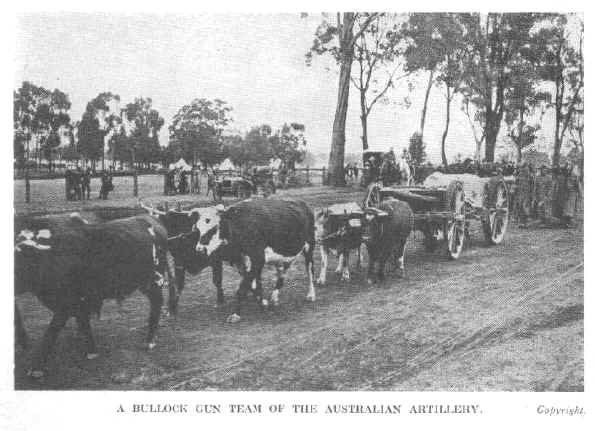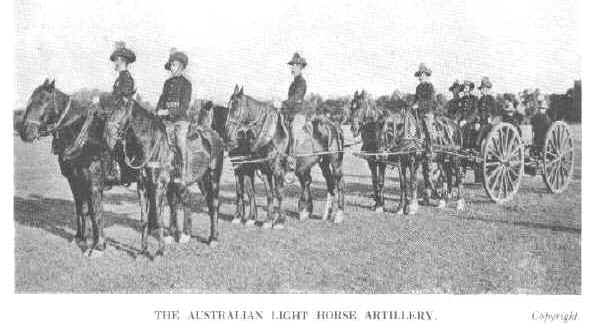|
THE
IMPERIAL EXPEDITIONARY FORCE.
LORD
KITCHENER visited Australia in 1909, and now 20,000 fully equipped and
trained soldiers from the Sunny Commonwealth will arrive shortly in this
country, in response to the Empire's call, to participate in the great
struggle for the maintenance, as Mr. Asquith has put it, "of the
interests vital not only to the British Empire, but of all that is worth
having in common civilization, and the future progress of mankind."
Lord
Kitcheners visit was made at the invitation of
Australia
in order that the young country might
have
the benefit of the great soldier's advice in preparing a scheme for the
defence of the island continent. Australia had already recognised that
the provision of a military force adequate to ensure local safety and
public confidence at a time of attempted invasion was to her a paramount
duty, and had adopted a system by which every male citizen should, with
certain exceptions and exemptions, undergo a course of military
training.

It
has been truly said that if on a map of the world all the countries
stained with the blood of war were marked, Australia would be the only
white spot. Australians arrived at the conclusion that the best way to
retain this enviable reputation was to be prepared. The total population
at the time did not exceed four and one half millions. There were over
ten thousand miles of coastline to defend, and a great country of
wonderful natural resources and wealth.
Up
to a short time previous to Lord Kitchener's visit the land defence was
practically carried out on voluntary and militia lines, and then for the
first time in any English‑speaking community compulsory service
was adopted. Lord Kitchener inspected the country and the men, and the
Government and military authorities were largely guided by his report.
This system was fully described in the November 21st issue of the NAVY
AND ARMY.
Today
many of the stalwart
Australians " Homeward " bound have passed through the course
of training laid down by the present War Secretary. With this system
in full operation, and with every patriotic young Australian thus
directly concerned, it was not surprising that when the Australian
Government called for men to make up the Expeditionary Force of 20,000
offered to the Motherland, there should have been a sufficient number of
eligible men offering to be included with the first and even a second
contingent.

Australia
had already enjoyed the distinction of being the first overseas
dependency to offer military aid to the Empire in the time of need.
Nearly thirty years ago (in 1885), with the greatest of enthusiasm, but
in circumstances vastly different from those obtaining today, Australia
equipped and despatched two batteries of artillery and 500
infantry
to Soudan. Then, as today, the men who offered their services were far
in excess of the number required. A contingent was also despatched in
connection with the Boxer rebellion in China.
Fifteen
years ago troopships also took to South Africa many, fine fighters from
Australia. It was here that Lord Roberts, Lord Kitchener and others had
an opportunity of seeing the rough young Australians in action. The
free, open air, rough‑and‑ready life of the colonial settler
had made him peculiarly suitable to the conditions in South Africa.
The
latest practical demonstration of Australian loyalty has been officially
named the Australian Imperial Expeditionary Force, and, briefly, its
composition has been described as ‑‑‑One Light Horse
Brigade and One Division." In making up this force an endeavour was
made to select one half of the rank and file from men in their 2oth year
or upwards, who were serving with the Australian colours, and the
remainder from trained men specially enlisted who had served in the
militia, in the Imperial forces, or had seen war service.
The
Light Horse Brigade is made up of three regiments of over 500 men each,
field artillery, light horse brigade ammunition column, signal troop,
light horse brigade train, field ambulance, army service corps and
headquarters staff. The approximate total of the personnel is 104
officers,
2,122
Of
other ranks, with 2,315 horses, machine guns, 18-pounder quick firers,
carts, wagons, motorcars, bicycles, motorcycles and a field wireless
equipment.
The
Division includes about 18,ooo troops of all ranks attached to
headquarters, infantry brigades, light horse squadrons, headquarters
divisional artillery, field artillery brigades, divisional ammunition
column, engineers, field companies, divisional train, field ambulances
and an army service corps. The division has also associated with it over
5,000 horses, 18-pounder quick-firers, machine guns, carts, wagons,
motor-cars, bicycles, and motor-cycles. The Infantry Brigade is made up
of four battalions, field artillery brigade, and three batteries of guns
and ammunition wagons, each drawn by six horses.
In
obtaining the staff of officers the system adopted seems to have been
for the Expedition Commander (Major-General Bridges) to nominate
his personal staff, and the various brigadiers. Brigade commanders then
chose their associates and battalion leaders, and these in turn selected
their company or squadron chiefs, who were also allowed to nominate
their subalterns. All were eventually submitted to the district
commandants in their respective capital cities before they were
confirmed by the Federal Executive Council.
The
ordinary Australian khaki uniform is being worn, with coloured ribbons
on the hat to distinguish the branches. The infantry will have green,
artillery scarlet, light horse white, engineers dark blue, signallers
Royal blue, army service blue and white, and army medical corps
chocolate.
The
units are self-contained in every particular except that they are
not bringing tents. The average Australian sleeps comfortably in the
open with the starry sky as his canopy, but in a winter campaign on the
continent, he would not fare as well. To provide for this, Lady Reid,
wife of the High Commissioner for the Australian Commonwealth in London,
has been instrumental in forming an Australian War Contingent
Association, and already stores are being filled in London with clothing
and comforts for the men from the Antipodes should they be asked to face
the rigour of a winter campaign on the Continent.
As
part of the great national scheme of naval and military defence the
Australian Government has established clothing, saddlery, ammunition and
small arms factories where the whole of the work is done under direct
Government supervision. These factories have been working at full
pressure since war was declared.
For
the transportation of Australia's contingent a fine fleet of vessels was
selected from those engaged in the passenger trade and the carriage of
mails between the United Kingdom and the Commonwealth. These include the
new Aberdeen liner, “Euripides," of 15,000 tons, and several 12,000
ton
liners of the Orient, P. & O and White Star companies. It is
interesting to note that Captain Douglas of the Euripides, who took the
fine new vessel to Australia on her maiden trip, has already had
experience in the carrying of troops. He transported the New South Wales
troops to Soudan, and the New South Wales Naval Brigade to China in
connection with the Boxer rebellion. |